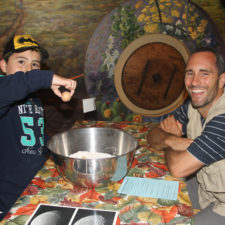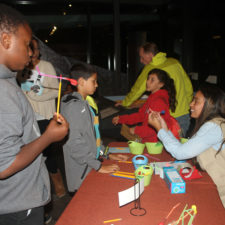Where were you on the night of June 22, 2017?
Don’t worry; we’re not asking for your alibi, but if you weren’t at the Nix Nature Center at Laguna Coast Wilderness Park, you missed something special. With stellar support from Laguna Canyon Foundation volunteers, OC Parks Resource Specialist Laura Cohen treated more than 50 visitors to a beautiful and educational night in the park.
The visitors – of every age – could engage in several activities, including participating in a constellation scavenger hunt, learning about the sizes of planets and why each might be a difficult environment for living things, and understanding the difference between astrology and astronomy.
OC Astronomers set up six powerful telescopes. Science Heads brought their mobile observatory in which aspiring astronomers could tour a “virtual solar system.” While the actual night of June 22 had a bit of a marine layer limiting celestial observations, visitors learned that this was the best time to see Saturn and Jupiter.
So, where will you be on August 21, 2017?
You might want to consider planting yourself in one of a few selected states: Oregon, Idaho, Wyoming, Nebraska, Kansas, Missouri…and continuing across the middle of the USA down to North and South Carolina. Why? Because it is in these states where the total solar eclipse can be seen on August 21, 2017.
A total solar eclipse occurs when a new moon comes between the sun and the earth, aligning just perfectly. It is a rare occurrence. The last time a total solar eclipse could be seen from the United States was in 1979 and only from a few Pacific Northwest States. If you’re a planner, check out the Washington Post’s interactive webpage, illustrating when your next shot would be.
What will we see? The better question might be: what will we experience? Imagine, during a bright sunny day in August, the moon covers – eclipses – the sun…dim, dim, dimming the sun’s light as it moves across the sky, until the day’s sky reveals stars and planets. Venus and Jupiter, for example, should be visible. Remarkable, right? The moon almost taking over the day from the sun, creating a dark circle in the sky, with the sun’s corona fanning around it like a muted, silvery sunflower.
Our universe is, of course, amazing. We at Laguna Canyon Foundation – staff, volunteers, board and partners – love learning about our earth and our surroundings. It helps us better understand how we can protect and preserve this canyon that we love.
OC Parks Resource Specialist Laura is already planning the next Astronomy night at the Nix, on October 28, 2017. On this night, International Observe the Moon Night, we will share lots of fun activities. So please join us for a wonderful – full of wonder – evening.








